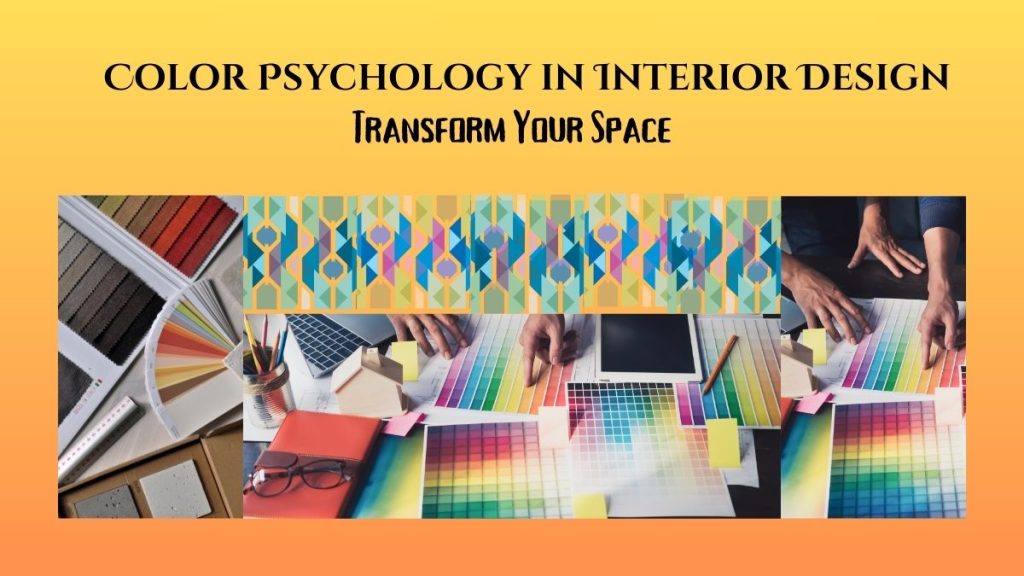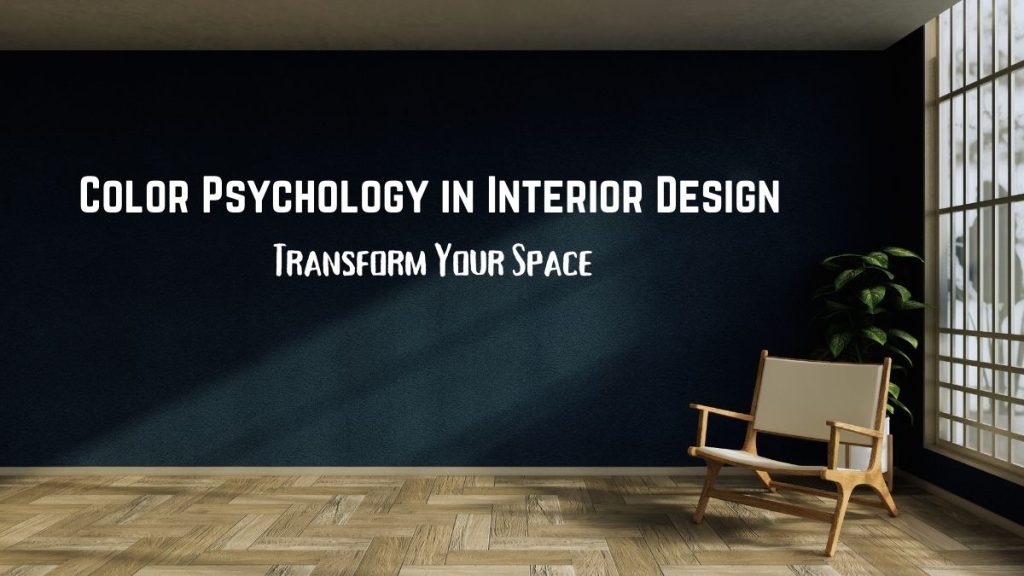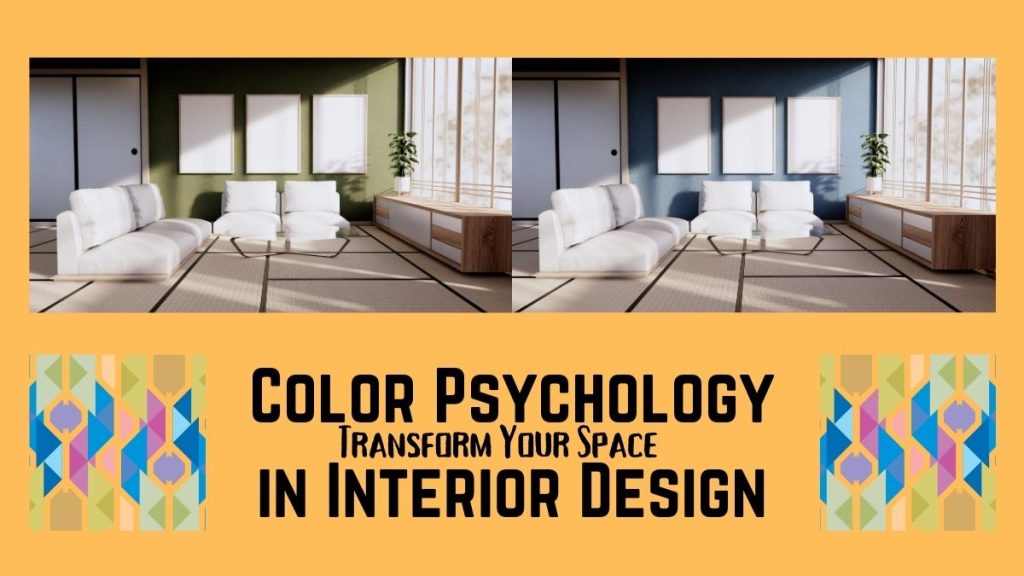Color psychology in interior design involves using colors to influence mood, perception, and behavior within a space. Different colors evoke distinct emotions and can enhance a room’s ambiance.
Understanding color psychology is crucial for creating harmonious and functional interior spaces. Colors like blue and green promote calmness and relaxation, ideal for bedrooms or living rooms. Red and yellow energize and stimulate, making them suitable for kitchens or workout areas.
Neutral tones such as beige and gray offer a balanced backdrop, allowing other design elements to stand out. The right color choices can transform a space, making it more inviting, productive, or soothing. Thoughtful color selection helps achieve the desired atmosphere, enhancing overall well-being and aesthetic appeal.
Related Article: Interior Design Tips for Beginners: Transform Your Space Today

Related Article: How to Learn Interior Design Yourself: Ultimate DIY Guide
You may also read: Minimalist Living Spaces: Transform Your Home with Less
Introduction To Color Psychology
Color psychology is the study of hues and their impact on human behavior. In interior design, colors can influence moods, feelings, and even actions. Choosing the right colors can transform a space and affect how people feel when they enter it.
The Basics Of Color Theory
Understanding color theory is key to mastering color psychology. The color wheel is the foundation. It shows the relationship between primary, secondary, and tertiary colors.
Primary colors are red, blue, and yellow. They cannot be made from other colors. Secondary colors are green, orange, and purple. They are made by mixing primary colors. Tertiary colors are made by mixing primary and secondary colors.
| Color Type | Examples |
|---|---|
| Primary Colors | Red, Blue, Yellow |
| Secondary Colors | Green, Orange, Purple |
| Tertiary Colors | Red-Orange, Blue-Green, Yellow-Green |
Colors can also be warm or cool. Warm colors, like red and yellow, evoke energy. Cool colors, like blue and green, create calmness.
The Influence Of Colors On Mood
Colors have a powerful effect on our emotions and moods. Here’s how different colors can influence feelings:
- Red: Increases energy and excitement. Great for social spaces.
- Blue: Promotes calm and relaxation. Ideal for bedrooms or bathrooms.
- Yellow: Encourages happiness and positivity. Perfect for kitchens and dining areas.
- Green: Brings a sense of nature and tranquility. Suitable for living rooms and offices.
- Purple: Adds luxury and creativity. Works well in bedrooms and studios.
Using color psychology in interior design can create a harmonious and inviting environment. By understanding how colors affect mood, you can make more informed design choices.
Related Article: Smart Home Design: Modify Your Space with Innovation

Credit: www.singhhomes.com
Related Article: Interior Design Basics: Transform Your Space with Style
You may also read: Grey Color Psychology in Interior Design: Mood Magic
Choosing The Right Colors
Choosing the right colors for your home can be exciting. Colors affect our mood and energy. The right shades can make a room feel cozy or lively. Understanding color psychology helps in making the best choices.
Assessing Your Space
First, assess the space you want to decorate. Look at the room size. Small rooms benefit from light colors. They make them feel bigger. Large rooms can handle darker shades. Also, consider the natural light. Rooms with lots of sunlight can use cool colors. Darker rooms need warm tones.
Personal Preferences And Styles
Think about your personal style. Do you like modern or traditional designs? Modern styles often use neutral colors. Traditional styles use warm, rich shades. Your favorite colors should also guide you. If you love blue, use it in your space. It creates a calm feeling.
Consider the function of the room. Bedrooms need relaxing colors like blue or green. Kitchens can use energetic colors like red or yellow. Here is a quick guide:
| Room | Suggested Colors |
|---|---|
| Living Room | Warm neutrals, soft blues |
| Bedroom | Soft greens, calming blues |
| Kitchen | Bright yellows, warm reds |
| Bathroom | Cool blues, fresh whites |
Remember, color psychology plays a big role in how we feel in a space. Choose colors that make you happy and comfortable.
Impact Of Warm Colors
Warm colors can transform a room’s atmosphere. They create feelings of warmth, energy, and comfort. Let’s explore the impact of warm colors in interior design.
Energizing Spaces With Red
Red is a powerful color. It stimulates excitement and energy. Use red in living rooms or kitchens to create lively spaces.
- Red walls can make a bold statement.
- Red accents like pillows or rugs add vibrancy.
Red can also increase appetite. This makes it a good choice for dining areas. But, use it sparingly to avoid overwhelming the space.
Creating Comfort With Orange
Orange is a warm and inviting color. It combines the energy of red and the happiness of yellow. Orange is perfect for spaces where you want to feel cozy and comfortable.
- Soft orange tones create a welcoming environment.
- Orange decor items add a cheerful touch.
Orange is ideal for living rooms or family rooms. It promotes social interaction and a sense of well-being. Use it in moderation to keep the space balanced.
Related Article: Room Makeover Ideas: Transform Your Space on a Budget

Related Article: Interior Design Lighting Ideas: Transform Your Space Effortlessly
Effect Of Cool Colors
Cool colors have a unique impact on our emotions and mental state. These colors, such as blue and green, are known for their calming and refreshing effects. In interior design, cool colors can transform a space into a serene and peaceful environment.
Calming Effects Of Blue
Blue is often associated with calmness and tranquility. It can reduce stress and create a sense of peace. This makes blue an ideal color for bedrooms and bathrooms. Light blue walls can make a room feel more spacious and airy.
Dark blue, on the other hand, adds a touch of elegance and sophistication. It can be used in living rooms or dining areas to create a formal and serene ambiance. Blue is also known to lower blood pressure and slow down the heart rate.
| Shade of Blue | Effect |
|---|---|
| Light Blue | Spacious and airy feeling |
| Dark Blue | Elegant and sophisticated |
Refreshing Ambiance With Green
Green is the color of nature and symbolizes growth and renewal. It has a refreshing and revitalizing effect. Green is perfect for living rooms and kitchens, where it can create a lively and energetic atmosphere.
Different shades of green can evoke different feelings. Light green brings a sense of freshness and calm. Dark green, like emerald or forest green, can add depth and richness to a space.
- Light Green: Fresh and calming
- Dark Green: Deep and rich
Green is also believed to help with concentration and relaxation. This makes it a great choice for home offices or study areas.
Neutral And Earth Tones
Neutral and earth tones have a timeless appeal in interior design. These colors create a calm and inviting atmosphere. They can also serve as a backdrop for more vibrant accents. This section explores the beauty and versatility of neutral and earth tones in home decor.
Creating Balance With Beige
Beige is a classic neutral that brings warmth and balance to any room. It pairs well with various colors and materials, making it a versatile choice.
- Beige walls create a serene environment.
- Beige furniture complements wooden floors.
- Beige accessories add subtle elegance.
Mixing different shades of beige can add depth. Combine light beige with darker tones for a layered look. Use beige in living rooms, bedrooms, and even kitchens to create a cozy feel.
Sophistication Of Gray
Gray is another popular neutral that exudes sophistication. It is versatile and can range from cool to warm shades. Gray works well in modern and traditional designs.
| Shade | Effect | Best Used In |
|---|---|---|
| Light Gray | Airy and calm | Bedrooms, living rooms |
| Charcoal Gray | Bold and dramatic | Dining rooms, offices |
| Warm Gray | Inviting and cozy | Kitchens, bathrooms |
Gray can be paired with bright colors for a striking contrast. It also works beautifully with other neutrals like white or beige. Use gray to create a sophisticated and modern space.
You may also read: Best Interior Design Books to Transform Your Home with Style

Related Article: Small Modern House Interior Design: Transform Your Space Today
Practical Tips For Using Color
Color psychology in interior design can transform your space. The right colors can evoke feelings and set the mood. Here are practical tips for using color in your home.
Color Combinations And Harmony
Choosing the right color combinations is crucial. Colors can clash or complement each other. Use the color wheel to find harmonious color schemes.
| Color Scheme | Description |
|---|---|
| Monochromatic | Uses different shades of the same color. |
| Analogous | Combines colors next to each other on the color wheel. |
| Complementary | Uses colors opposite each other on the color wheel. |
Monochromatic schemes are soothing and harmonious. They are great for creating a calm and unified look.
Analogous schemes offer more variety while maintaining harmony. Use this scheme for a lively and balanced space.
Complementary schemes are bold and vibrant. They add energy and contrast to a room.
Accents And Accessories
Accents and accessories are perfect for adding color without overwhelming a space. Start with neutral walls and large furniture.
- Pillows: Add colorful pillows to your sofa or bed.
- Rugs: A bright rug can anchor a room.
- Art: Use colorful artwork to create a focal point.
Use these elements to introduce pops of color. This method allows for easy updates. You can change the accents with the seasons or trends.
Remember to balance the colors. Too many bright colors can be overwhelming. Use a mix of bold and neutral tones for the best effect.
Related Article: Modern Scandinavian Interior Design: Timeless Elegance Redefined
You may also read: Very Small Kitchen Ideas on a Budget: Maximize Space!
Conclusion
Understanding color psychology can transform your living space. Use the right colors to evoke desired emotions. Experiment with different shades to find your perfect balance. Remember, your home reflects your personality. Embrace color psychology in your interior design for a harmonious and inviting atmosphere.
Happy decorating!
Related Article: Sustainable Interior Design: Make Your Home Eco-Friendly
You may also read: Modern Bohemian Interior Design: Rebuild Your Space Effortlessly

Pingback: Small Modern House Interior Design: Transform Your Space Today - SpaceArc
Pingback: Grey Color Psychology in Interior Design: Mood Magic - SpaceArc